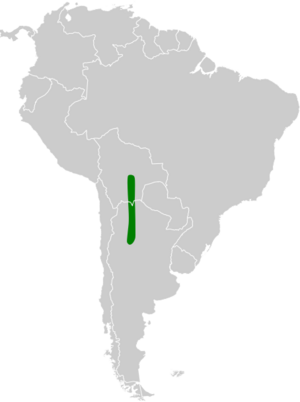Rothschild's swift facts for kids
Quick facts for kids Rothschild's swift |
|
|---|---|
| Conservation status | |
| Scientific classification | |
| Genus: |
Cypseloides
|
| Species: |
rothschildi
|
 |
|
The Rothschild's swift (Cypseloides rothschildi) is a special bird known for its fast flight. It belongs to the swift family and lives in parts of Argentina and Bolivia. This bird is currently listed as Near Threatened. This means its numbers are not in immediate danger, but they need to be watched closely.
Contents
About the Rothschild's Swift
What is a Superspecies?
The Rothschild's swift is part of a group of birds called a superspecies. This means it is very closely related to a few other swift types. These include the white-chested swift, the American black swift, and the sooty swift. Some experts even thought the Rothschild's swift and the sooty swift might be the same species. However, the Rothschild's swift is now seen as its own unique type.
How to Spot a Rothschild's Swift
This swift is about 15 cm (5.9 in) long. That's about the length of a regular pencil. It has long, wide wings that help it fly quickly. Its tail is short and looks a bit square. The bird's feathers are a plain, medium brown color all over.
Where Rothschild's Swifts Live
Their Home Range
You can find the Rothschild's swift in Bolivia, especially in the Santa Cruz Department. From there, its home stretches south into northwestern Argentina. It has been seen as far south as Córdoba Province. Even though some lists say it lives in Peru, there are no actual records of it there.
Preferred Habitat
Scientists are still learning about where these swifts like to live. Most of the time, they are seen flying over mountain forests. These forests are usually green all year round. They live at heights between 500 and 2,000 m (1,600 and 6,600 ft) above sea level.
Rothschild's Swift Behavior
Migration and Movement
It seems that Rothschild's swifts stay in their homes for most of the year. They are considered "year-round residents" in many areas. However, they might move to the northern parts of their range during the colder months.
What They Eat
Like all swifts, the Rothschild's swift catches its food while flying. It eats insects that it finds in the air. We don't know many specific details about what kinds of insects it prefers to eat.
Life Cycle and Reproduction
We don't know much about how Rothschild's swifts raise their young. Scientists are still trying to learn about their breeding habits and when they have babies.
How They Sound
It's quite rare to hear a Rothschild's swift. As of late 2022, there was only one recording of its voice on a website called xeno-canto. The Cornell Lab of Ornithology's Macaulay Library had no recordings at all. People who have heard them say they make a short "pip" or "peep" sound when they are flying.
Conservation Status
Why They Are Near Threatened
The IUCN (International Union for Conservation of Nature) has decided that the Rothschild's swift is a Near Threatened bird. This means their numbers are not very high, but they are not in immediate danger of disappearing.
Their home range is quite small. Experts believe there are between 6,000 and 15,000 adult birds. This number seems to be staying steady, which is good news. However, much of the Yungas forest where they live has been cut down for wood or turned into farmland. The good news is that these birds can be found in some areas that are protected by law.


